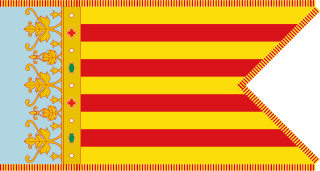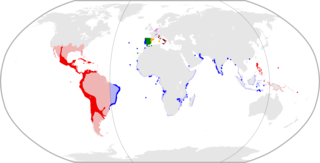
The Cortes Generales are the bicameral legislative chambers of Spain, consisting of two chambers: the Congress of Deputies and the Senate. The members of the Cortes are the representatives of the Spanish people.

The Kingdom of Valencia, located in the eastern shore of the Iberian Peninsula, was one of the component realms of the Crown of Aragon. When the Crown of Aragon merged by dynastic union with the Crown of Castile to form the Kingdom of Spain, the Kingdom of Valencia became a component realm of the Spanish monarchy.

The Revolt of the Comuneros was an uprising by citizens of Castile against the rule of Charles V and his administration between 1520 and 1521. At its height, the rebels controlled the heart of Castile, ruling the cities of Valladolid, Tordesillas, and Toledo.

Maestranzas de caballería are noble militias created in the early modern era by the Spanish Crown, with the aim of giving the nobility practice in horsemanship and the use of weapons. In the sixteenth century, the caballería or cavalry, was the typical military branch for nobles to follow, but the aforementioned skills had become less common as the Spanish aristocracy converted into a class of courtiers. These noble institutions created a dedicated cavalry corps that was directly funded by its members. The participating nobles, or maestrantes, organized themselves under the advocacy of a holy patron and took the internal form of a confraternity.

The Council of Castile, known earlier as the Royal Council, was a ruling body and key part of the domestic government of the Crown of Castile, second only to the monarch himself. It was established under Queen Isabella I in 1480 as the chief body dealing with administrative and judicial matters of the realm. With the 1516 ascension of King Charles I to the throne of both Castile and Aragon, the Royal Council came to be known as the Council of Castile because Charles was king of many dominions other than Castile, while the Council retained responsibility only over Castile.

In the 16th, 17th and 18th centuries, the regenten were the rulers of the Dutch Republic, the leaders of the Dutch cities or the heads of organisations. Though not formally a hereditary "class", they were de facto "patricians", comparable to that ancient Roman class. Since the late Middle Ages Dutch cities had been run by the richer merchant families, who gradually formed a closed group. At first the lower-class citizens in the guilds and schutterijen could unite to form a certain counterbalance to the regenten, but in the course of the 15th century the administration of the cities and towns became oligarchical in character. From the latter part of the 17th century the regent families were able to reserve government offices to themselves via quasi-formal contractual arrangements. In practice they could only be dislodged by political upheavals, like the Orangist revolution of 1747 and the Patriot revolt of 1785.

The Revolt of the Brotherhoods was a revolt by artisan guilds (Germanies) against the government of King Charles V in the Kingdom of Valencia, part of the Crown of Aragon. It took place from 1519–1523, with most of the fighting occurring during 1521. The Valencian revolt inspired a related revolt in the island of Majorca, also part of Aragon, which lasted from 1521–1523.
The Second Brotherhood was an uprising in the central regions of the Kingdom of Valencia of Habsburg Spain in 1693. The protesters named themselves agermanats after the germanies ("brotherhoods") or guilds of Valencia who had revolted in 1519 in the Revolt of the Brotherhoods, but the two revolts are quite different in their supporters and the social context in which they occurred. Rather than a revolt by middle-class guildsmen, the Second Brotherhood was a peasant revolt against high rents on farmland and crops. Additionally, the Second Brotherhood was resolved far faster and far more peaceably than the violence of the 1519 revolt in both the rebels' actions and the government's subsequent repression.
Military conflict in the Revolt of the Comuneros spanned from 1520 to 1521. The Revolt began with mobs of urban workers attacking government officials, grew to low-level combat between small militias, and eventually saw massed armies fighting battles and sieges. The comunero rebels gained control of most of central Castile quite quickly, and the royal army was in shambles by September 1520. However, the comuneros alienated much of the landed nobility, and the nobility's personal armies helped bolster the royalist forces. The Battle of Tordesillas in December 1520 would prove a major setback for the rebels, and the most important army of the comuneros was destroyed at the Battle of Villalar in April 1521.
The Hidden was a mysterious and charismatic leader of the remnants of the rebels in the last stages of the Revolt of the Brotherhoods in the Kingdom of Valencia, then under the rule of the Crown of Aragon. Also called "The Hidden King", he claimed to be a prince hidden for his own safety now showing himself by divine command to save Spain from ruin. The Hidden unified the rebels for a short period, inspiring messianic fervor among his followers. He led them on hit-and-run raids against the royal government, uncooperative nobles, and Muslim peasants (mudéjars). The Hidden was killed in Burjassot on May 18, 1522, and the rebellion soon collapsed afterward. His true name and lineage are unknown.
Vicent Peris was a weaver and leader of the weavers' guild in Valencia. He came to prominence as the most influential leader of the Council of Thirteen after the death of Joan Llorenç in the Revolt of the Brotherhoods. Peris saw the revolution as a wider social revolution against the nobility, and aggressively attacked them. He also legitimized the anti-Muslim stance of many rebels into the Germanies government, and intensified their repression.

The Mendoza family was a powerful line of Spanish nobles. Members of the family wielded considerable power, especially from the 14th to the 17th centuries in Castile. The family originated from the town of Mendoza in the province of Álava in the Basque countries, with the seigneury becoming part of the Kingdom of Castile during the reign of Alfonso XI (1312–1350).

The Strasbourg massacre occurred on February 14, 1349, when several hundred Jews were publicly burnt to death, and the rest of them expelled from the city as part of the Black Death persecutions. It was one of the first and worst pogroms in pre-modern history.
The Brotherhoods of Mallorca was a revolt against the urban middle-class and the high nobility, in part influenced by the Revolt of the Brotherhoods in the Kingdom of Valencia, which occurred in 1521 as a consequence of the imprisonment of seven artisans.
The Harelle was a revolt that occurred in the French city of Rouen in 1382 and followed by the Maillotins uprising a few days later in Paris, as well as numerous other revolts across France in the subsequent week. France was in the midst of the Hundred Years' War, and had seen decades of warfare, widespread destruction, high taxation, and economic decline, made worse by bouts of plague. In Rouen, the second largest city in the kingdom, the effects of the war were particularly felt. Tensions had been building nationally for nearly a year following the death of Charles V; on his deathbed he repealed many of the war taxes he had previously imposed. With the re-imposition of the taxes months later, a localized revolt led by Rouen's guilds, occurred in the city and was followed by many similar such incidents across the kingdom. Charles VI traveled with an army led by his uncle and regent, Philip the Bold Duke of Burgundy, from Paris. Paris itself revolted shortly after the army left the city. After returning to Paris to deal with the rebels there, the Duke and King traveled with an army to Rouen to end the revolt. The leaders of the Harelle in Rouen feared execution on the scale that occurred in Paris, and resolved to not resist the army. Twelve leaders of the revolt were executed, the city's rights were revoked and it was put under the rule of a royal governor, and a fine of 100,000 francs was imposed. Despite the victory, the King was unable to re-enforce the taxation that prompted the revolt, and spent most of the next two years putting down similar tax revolts around the kingdom that followed the example of Rouen. The Harelle was one of many popular revolts in late medieval Europe, including the English peasants' revolt of 1381 one year earlier, all part of a larger crisis of the Late Middle Ages.
The croquant rebellions were several peasant revolts that erupted in Limousin, Quercy, and Perigord (France) and that extended through the southeast of the country in the latter part of the 16th and beginning of the 17th centuries.










